A Surprising Landscape-Bagan Myanmar
Bagan Myanmar
Bagan or Pagan is an ancient city and a UNESCO World Heritage Site in the Mandalay Region of Myanmar. Bagan Myanmar is a sacred landscape, featuring an exceptional range of Buddhist art and architecture, located Ayeyarwady River in the central plain of Myanmar. The seven components of the area include numerous temples, stupas, monasteries, and Pagodas as well as archaeological remains and sculptures. Bagan is a spectacular testimony of Bagan civilization (11th -13th centuries CE) when the site was the capital of a regional empire. The monumental architecture reflects the strength of religious devotion of an early Buddhist empire. During this period, the Bagan civilization gained control of river transport, extending its influence over a large area.
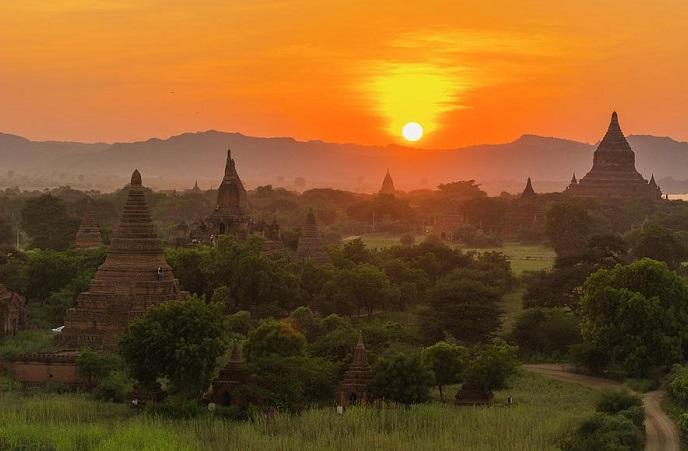
Seven of the components are located on one side of the River, and one is located on the opposite side. The Bagan area reflects Buddhist worship and merit-making activities, traditional cultural practices, and farming. The Buddhist consists of 3,595 recorded monuments including stupas, temples, and other structures for Buddhist spiritual practice, archaeological sites, and many inscriptions, murals, and sculptures. Bagan also incorporates living communities and contemporary urban areas. The authenticity of Bagan is demonstrated by the landscape of Buddhist monuments of diverse sizes, scales, materials, designs, and antiquity; and the rich and continuing religious and cultural traditions. The Structure is extensive damages resulting from earthquakes.
Geography
The Bagan Archaeological area is 13 by 8 kilometers centered around Old Bagan, consisting of Nyaung U in the north and New Bagan in the south. It lies in the vast expanse of plains in Upper Burma on the bend of the Irrawaddy river. It is located 290 kilometers southwest of Mandalay and 700 kilometers north of Yangon. Myanmar, formerly known as Burma, is a Southeast Asian nation, bordering India, Bangladesh, China, Laos, and Thailand. Myanmar’s largest city and former capital, Yangon (Rangoon) which is now known as Naypyidaw, is home to modern-style markets, numerous parks, and colonial-style buildings. The country’s terrain encompasses the Andaman Sea and the Bay of Bengal, tropical rainforests, arid plains, and deserts. Bagan Myanmar Map shows the location of Bagan monuments from Yangoon. The map displays the location of several relevant places in Myanmar. Bagan is located south on the coast of the Andaman Sea, while Ngapali to the west lies on the Bay of Bengal. visitors can also extend their trip to hike Mount Victoria in the Chin State or paddle around the famous Inle Lake up in the Shan Hills.
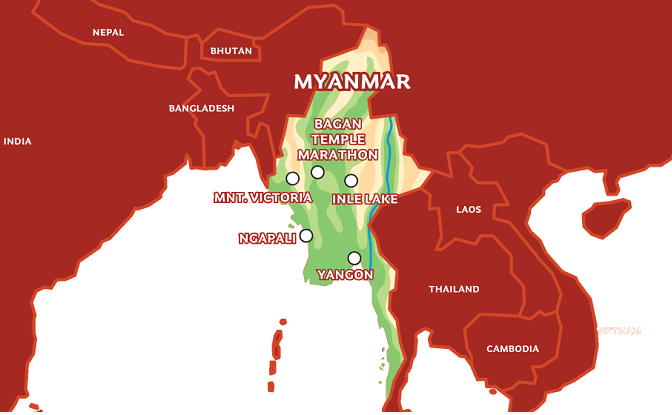
Bagan Myanmar History
According to the Myanmar literature Bagan was founded in the second century AD, and fortified in 849 AD by King Pyinbya, the 34th successor of the founder of early Bagan. however, some scholar says that Bagan was founded in the mid-to-late 9th century by the Burmans, who entered the Irrawaddy valley from the Nanzhao Kingdom. From 1044 to 1287, Bagan was the capital as well as the political, economic, and cultural center of the Bagan Empire. Over the course of 250 years, Bagan’s rulers constructed over 10,000 religious monuments including 1000 stupas, 10,000 small temples, and 3000 monasteries in an area of 104 square kilometers in the Bagan plains. The prosperous city grew in time and became a cosmopolitan center for religious and secular studies. The center is specializing in Pali scholarship in grammar and philosophical-psychological studies as well as works in a variety of languages on prosody, phonology, grammar, astrology, alchemy, medicine, and legal studies. The Bagan city attracted monks and students from as far as India, Sri Lanka, and the Khmer Empire. The culture of Bagan was dominated by religion. It was largely a continuation of religious trends in the Pyu era where Theravada Buddhism co-existed with Mahayana Buddhism, Tantric Buddhism, various Hindu schools as well as native traditions.

Climate
Bagan lies in the middle of the “dry zone” of Burma, the region is located between Shwebo in the north and Pyay in the south. Unlike the coastal regions of the country, which receive annual monsoon rainfalls exceeding 2,500 millimeters, the dry zone gets little precipitation as it is sheltered from the rain by the Rakhine Yoma mountain range in the west.
Read more- Rock Sculpture of Decebalus-A Great Marvel at Romanian Riverside
Bagan Myanmar Hot Balloons
Hot air balloons beautifully cloud the historic Bagan sky. Bagan’s balloons have become an iconic symbol of the region, and have carried many travelers on soaring adventures of a lifetime. Here’s how to experience an unforgettable birds-eye view of Bagan, Myanmar. Balloons Over Bagan has two balloon flight options – classic and premium. Passengers are picked up, then treated to a light pre-flight breakfast while the balloons are filled. Classic balloon baskets fit up to around 10 riders each. For a more intimate, in-flight journey, the premium choice has smaller baskets that fit 8 travelers at most, with separate compartments for couples. It also includes an interactive tour and a continental breakfast. Ballooning season in Bagan runs from October to the middle of April. Most rides are offered at Sunrise, as the cooler morning temperatures allow balloons to float closer to the ancient stupas for the best glimpse.
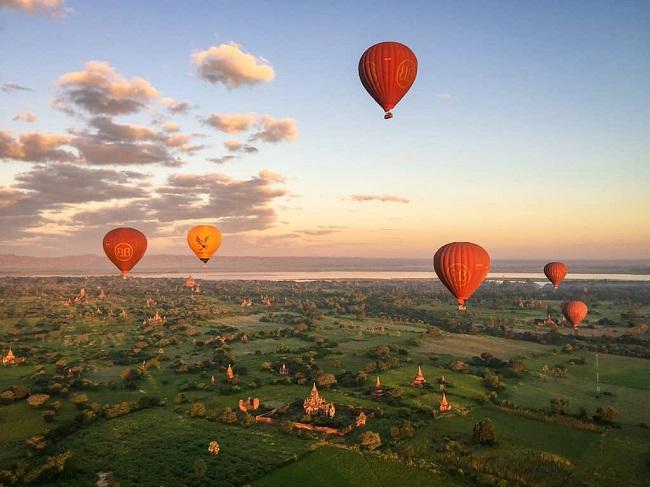
How to get to Bagan Myanmar
Bagan is located in the Mandalay region of Myanmar, approximately 630 km north of Myanmar’s largest city, Yangon. It was the capital of the Pagan Kingdom. The most common way to get to Bagan is to fly into Yangon International Airport and then take a domestic flight to Nyaung-U Airport, which is the closest airport to Bagan. You can also take a bus or train from Yangon to Mandalay and then take a local bus or taxi from Mandalay to Bagan.
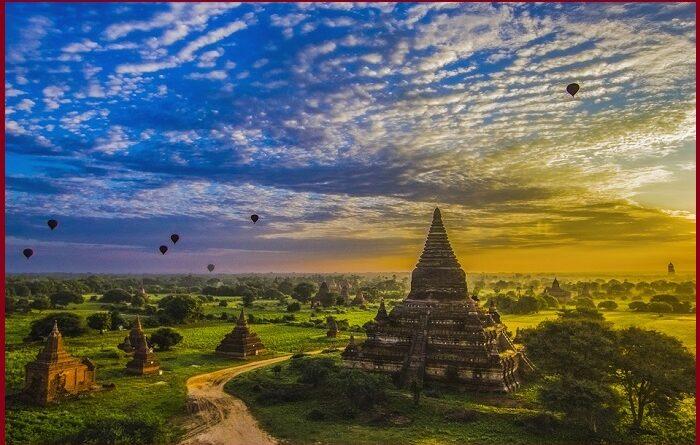
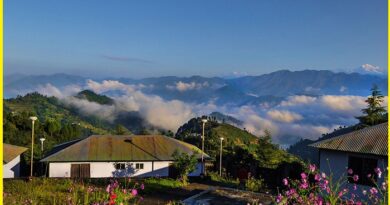
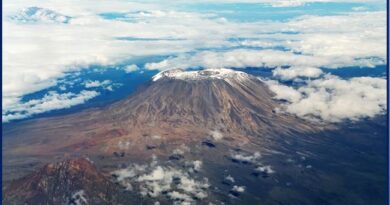
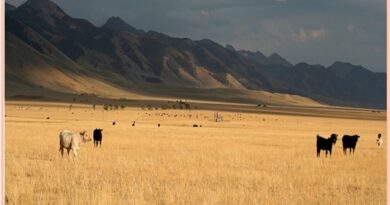
Pingback: Sicily Italy-A dazzling island in Mediterranean Sea - Geotourism